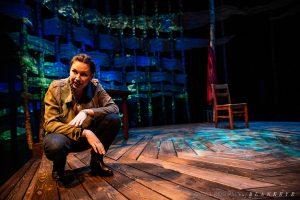
DeLanna Studi – Courtesy of Owens Daniel Photography. Used with permission.
It was a banner weekend for people of color on the Indianapolis theatre scene. Thai American playwright Prince Gomolvilas’ “The Brothers Paranormal” opened Friday at Fonseca Theatre Company, a platform for minority voices. On that same night, Indiana Repertory Theatre presented the Midwest premiere of “And So We Walked: An Artists Journey Along the Trail of Tears” on its Upperstage. The first production of IRT’s INclusion Series, which is focused on diverse storytelling, the one-woman play is written by and stars DeLanna Studi, a Cherokee actor and activist.
The absorbing drama, directed by Corey Madden, tells the story of Studi’s six-week journey with her father to retrace the steps of the 900-mile trail from North Carolina to Oklahoma, traveled by tribe members during their forced removal from their homeland by the U.S. Government in the 1830s. Cherokee on her father’s side and German-Irish on her mother’s, Studi sought to explore not only this shameful and often untold chapter of our nation’s history, but the history of the Cherokee Nation and the marginalization of native people that continues today. Through the journey, she also hoped to connect further with her father, who had a deep pride in his ancestors’ traditions and language.
Studi’s performance itself was truly mind-blogging in terms of the length of time she was on stage and the concentration and focus it took for her to hold the audience’s attention for the play’s run time of two hours and 30 minutes (with a 15-minute intermission). As is my habit, I took a moment to observe the audience at different points during her performance and all I saw was a mesmerized audience at rapt attention.
Contributing to my enjoyment of Studi’s epic yet intimate story, were the play’s production elements. They included a simple wooden, hexagon-shaped, raised platform, which served as Studi’s main playing area and behind it were a series of tree limbs woven with rows of, what appeared to be fabric cut to resemble clouds. Projected on the material were marvelous videos and still images by Norman Coates, who also designed the show’s lighting, which was pitch perfect for the mood and ambiance they created. Adding to the show’s indegenous flavor was the sound design of Bruno Louchouarn, John-John Grant & Sarah Elizabeth Burkey and costumes by Andja Budincich.
Though the story does highlight the profound loss and trauma suffered by her people (4,000 died from hunger, exposure and disease), it also pays tribute to their fortitude and the hope sustained by the survivors, who continue to remain optimistic as they navigate living in an often hostile, modern world, while still holding on to their identities. For those fearful the play might be too depressing, I emphasize that Studi, who weaves her own personal story into the show. Sharing her conflicts with her dad, struggles with romantic relationshsip and her life as a working actor, she did so with humor, and through her vibrant stage personality, kept me engaged throughout.
For me, the play’s subject matter was heightened by the fact that my own documented ancestors, who were Aztec Indian, suffered extinction at the hands of conquerors and colonizers. With the popularity of web services such as Ancestory.com and others, those who are interested in their own personal history and history in general will identify with Studi’s search for her beloved roots and celebration of her past. Like Studi, whose Cherokee beliefs include the notion that there is such a thing as “blood memory,” I believe my ancestors’ past informs my own life and will always remain a part of who I am.
For tickets and information about “And So We Walked: An Artist’s Journey Along the Trail of Tears,” call (317) 635-52-5252 or visit irtlive.com.





